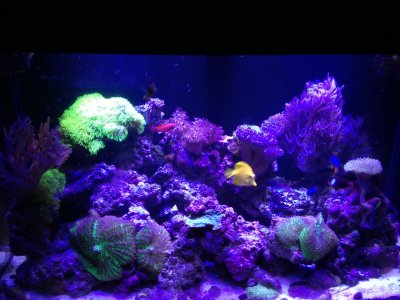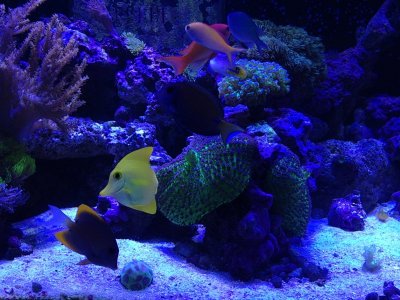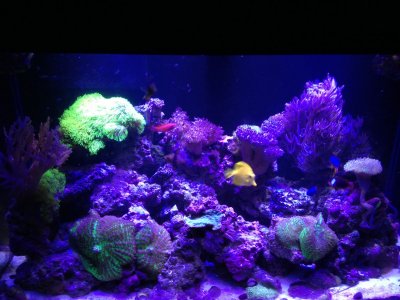Navigation
Install the app
How to install the app on iOS
Follow along with the video below to see how to install our site as a web app on your home screen.
Note: This feature may not be available in some browsers.
More options
You are using an out of date browser. It may not display this or other websites correctly.
You should upgrade or use an alternative browser.
You should upgrade or use an alternative browser.
Selecting a LED Fixture - By Steven Pro
- Thread starter revhtree
- Start date
- Tagged users None
- Joined
- Aug 28, 2015
- Messages
- 387
- Reaction score
- 58
i had an other question
iv seen in some shops they use colorful LEDs on reef tanks is that good or not????
for examole pink, purple ,green, yellow,etc..
Do reefs survive undre this kind of lightning????
iv seen in some shops they use colorful LEDs on reef tanks is that good or not????
for examole pink, purple ,green, yellow,etc..
Do reefs survive undre this kind of lightning????
- Joined
- Jul 20, 2015
- Messages
- 12
- Reaction score
- 10
I would highly recommend a reef breeders I love the three I've had they are really strong though almost to bright when turned up over 90 percent my pics don't do this light justice it doesn't look as blue as the picture looks in real life all the colors pop out. Plus seeing great coral growth. One pic with the green star polyps up top is my 65 gallon with a 24" reef breeders photon then the othe tank is my 120 gallon with the 48" I upgraded tanks and sold the old tank. I'll put up recent pics of the 120
Attachments
I need some appropriate suggestions...I've gotten all sorts of answers and am now just overwhelmed with options...I've got a 45 gal bowfront 36" wide 20" deep...what are some specific recommendations...I'm not looking to handle clams or SPS, so I don't think I need the most powerful units
Thanks in advance
Art
Thanks in advance
Art
- Joined
- Jun 4, 2015
- Messages
- 229
- Reaction score
- 70
It depends on how much u truly want to spend. Remember the most expesive is not always best personally I use to of the eBay dimmable black box led they r inexpensive but if I had the money I would have bought radions just read all the choices out there and set a budget.
- Joined
- Jul 20, 2015
- Messages
- 12
- Reaction score
- 10
Reef breeders leds all day The 24" would work great for any tank 36" I had it on a 60 gallon here it is. Amazing colors growth and health and ease of use the pic is the 60 gallon I have a 120 currently with the 48" reef breeders

- Joined
- Nov 7, 2015
- Messages
- 7
- Reaction score
- 1
Anyone have any input on either the Hydra or the Radion leds? I'm trying to make my decision on the world of led reef lighting. I have LPS but just added some montipora and I wanna get into the sps
Hello guys just wanted to update you guys I purchased a current (http://www.ebay.com/itm/LED-AQUARIU...557404?hash=item4192ab0b9c:g:SUkAAOSwBLlVCYLd) I purchased from my local pet store buy I've also found it on here i could be happier it comes with a ton of great features i highly recommend it
Thoughts on RapidLED Onyx lights? I heard they compare to Radions?
It's what I run over my display. I'm completely satisfied with them.
Here's a video.
In my humble opinion, buying a LED fixture I would look for:
- brand and type of LEDs - we cannot dream to see flux / color bins on a fixture, but yeah, this would be more pricey. Those binnings are the main reason that not 2 lights are identical (even the same model of fixture can have 20-30% difference just thanks to unbinned LEDs). But also hate the "ultra efficient LEDs" slogan on some lights
- take the published power and consider only 75% of it in best case. All LEDs manufacturers websites publishes graphs and studies on which conditions have a light fixture to fulfill in order to be able to power a LED at 100% power. I have doubts that a small heatsink and a cheap fan can keep dozens of LEDs in a low enough temperature. As result the lifetime of LED drops (read intensity level in next few months) and in worst case color shifts. I would never power a led at more than 75% current without knowing lot of thermal details.
- leds to be clustered as close possible - to avoid ghosting / disco effects
- personally I consider collimators useless and prefer bare leds, as much wider / uniform spread. Someone will tell me that with collimators PAR values increase, etc. Agree, increase locally, right under the light. Keeping uncollimated LEDs I dont lost energy - everything is there, in the tank, everywhere. I can place corals everywhere in the tank, no risk to burn them, not risk to underfeed them.
- everybody admits that corals needs 400-500 nm spectral range to grow, with highest peak at 450 nm. Great. But then why PAR is an essential parameter?? PAR means radiometric power measured on 400-700 nm interval.
Having a lime/green/yellow light will show a huge PAR reading, but I will should not try it above a reef tank. Probably algaes will explode . Lumens / Lux are also useless parameters as are related to human eye sensitivity (V lambda curve for who needs more details) and will show you couple of lux on a high power deep blue led. I would consider radiometric power in 400-500 nm interval as the main parameter. All other wavelengths (500-650) - greens, yellow, red, far red, lime and whatever other leds are on market are for visual appealing of tank only. Not influencing the corals.
. Lumens / Lux are also useless parameters as are related to human eye sensitivity (V lambda curve for who needs more details) and will show you couple of lux on a high power deep blue led. I would consider radiometric power in 400-500 nm interval as the main parameter. All other wavelengths (500-650) - greens, yellow, red, far red, lime and whatever other leds are on market are for visual appealing of tank only. Not influencing the corals.
- safety features of the lights - what happens if the 2USD fan breaks? What if airflow is clogged? Will a thousand $ light just burn out?? Most probably components as fans have a much shorter lifetime than a well cooled/decently powered LED, so a nice way to replace it / clean it is essential.
And other details which convinced me in the end to not buy, but to build my own lights... If something goes wrong I can look into mirror, blame myself and repair/improve . Easier.
. Easier.
There are manufacturers of LED lights which provide books of details on the lights, including X-Rays for LEDs soldered on boards to prove that there are no micro air-bubbles in the solder to affect the thermal transfer... Sadly non of those guys plan to build reef lights . Hopefully the hobby market will mature someday and real pro lights will pop on shops.
. Hopefully the hobby market will mature someday and real pro lights will pop on shops.
- brand and type of LEDs - we cannot dream to see flux / color bins on a fixture, but yeah, this would be more pricey. Those binnings are the main reason that not 2 lights are identical (even the same model of fixture can have 20-30% difference just thanks to unbinned LEDs). But also hate the "ultra efficient LEDs" slogan on some lights
- take the published power and consider only 75% of it in best case. All LEDs manufacturers websites publishes graphs and studies on which conditions have a light fixture to fulfill in order to be able to power a LED at 100% power. I have doubts that a small heatsink and a cheap fan can keep dozens of LEDs in a low enough temperature. As result the lifetime of LED drops (read intensity level in next few months) and in worst case color shifts. I would never power a led at more than 75% current without knowing lot of thermal details.
- leds to be clustered as close possible - to avoid ghosting / disco effects
- personally I consider collimators useless and prefer bare leds, as much wider / uniform spread. Someone will tell me that with collimators PAR values increase, etc. Agree, increase locally, right under the light. Keeping uncollimated LEDs I dont lost energy - everything is there, in the tank, everywhere. I can place corals everywhere in the tank, no risk to burn them, not risk to underfeed them.
- everybody admits that corals needs 400-500 nm spectral range to grow, with highest peak at 450 nm. Great. But then why PAR is an essential parameter?? PAR means radiometric power measured on 400-700 nm interval.
Having a lime/green/yellow light will show a huge PAR reading, but I will should not try it above a reef tank. Probably algaes will explode
- safety features of the lights - what happens if the 2USD fan breaks? What if airflow is clogged? Will a thousand $ light just burn out?? Most probably components as fans have a much shorter lifetime than a well cooled/decently powered LED, so a nice way to replace it / clean it is essential.
And other details which convinced me in the end to not buy, but to build my own lights... If something goes wrong I can look into mirror, blame myself and repair/improve
There are manufacturers of LED lights which provide books of details on the lights, including X-Rays for LEDs soldered on boards to prove that there are no micro air-bubbles in the solder to affect the thermal transfer... Sadly non of those guys plan to build reef lights
ive heared that if the kelvin of light gows higher than 14000k the corals do not survive more than 1 year for example 25000k[/QU
Had to repost as what I'm typing is part of Arman's quote for some reason
Last edited:
Go to this link for lighting information: http://www.americanaquariumproducts.com/Aquarium_Lighting.html
@arman[/QUOTE]
@arman[/QUOTE]
WOW- now that is a write up!! my head is spinning......
In my humble opinion, buying a LED fixture I would look for:
- brand and type of LEDs - we cannot dream to see flux / color bins on a fixture, but yeah, this would be more pricey. Those binnings are the main reason that not 2 lights are identical (even the same model of fixture can have 20-30% difference just thanks to unbinned LEDs). But also hate the "ultra efficient LEDs" slogan on some lights
- take the published power and consider only 75% of it in best case. All LEDs manufacturers websites publishes graphs and studies on which conditions have a light fixture to fulfill in order to be able to power a LED at 100% power. I have doubts that a small heatsink and a cheap fan can keep dozens of LEDs in a low enough temperature. As result the lifetime of LED drops (read intensity level in next few months) and in worst case color shifts. I would never power a led at more than 75% current without knowing lot of thermal details.
- leds to be clustered as close possible - to avoid ghosting / disco effects
- personally I consider collimators useless and prefer bare leds, as much wider / uniform spread. Someone will tell me that with collimators PAR values increase, etc. Agree, increase locally, right under the light. Keeping uncollimated LEDs I dont lost energy - everything is there, in the tank, everywhere. I can place corals everywhere in the tank, no risk to burn them, not risk to underfeed them.
- everybody admits that corals needs 400-500 nm spectral range to grow, with highest peak at 450 nm. Great. But then why PAR is an essential parameter?? PAR means radiometric power measured on 400-700 nm interval.
Having a lime/green/yellow light will show a huge PAR reading, but I will should not try it above a reef tank. Probably algaes will explode. Lumens / Lux are also useless parameters as are related to human eye sensitivity (V lambda curve for who needs more details) and will show you couple of lux on a high power deep blue led. I would consider radiometric power in 400-500 nm interval as the main parameter. All other wavelengths (500-650) - greens, yellow, red, far red, lime and whatever other leds are on market are for visual appealing of tank only. Not influencing the corals.
- safety features of the lights - what happens if the 2USD fan breaks? What if airflow is clogged? Will a thousand $ light just burn out?? Most probably components as fans have a much shorter lifetime than a well cooled/decently powered LED, so a nice way to replace it / clean it is essential.
And other details which convinced me in the end to not buy, but to build my own lights... If something goes wrong I can look into mirror, blame myself and repair/improve. Easier.
There are manufacturers of LED lights which provide books of details on the lights, including X-Rays for LEDs soldered on boards to prove that there are no micro air-bubbles in the solder to affect the thermal transfer... Sadly non of those guys plan to build reef lights. Hopefully the hobby market will mature someday and real pro lights will pop on shops.
I think you might enjoy this read at this lighting link: http://www.americanaquariumproducts.com/Aquarium_Lighting.html
I think you might enjoy this read at this lighting link: http://www.americanaquariumproducts.com/Aquarium_Lighting.html
Sorry, but I red it before and not agree with lots of things in there.
Curious, Like what and why?Sorry, but I red it before and not agree with lots of things in there.
Similar threads
- Replies
- 1
- Views
- 102
- Replies
- 1
- Views
- 172






















